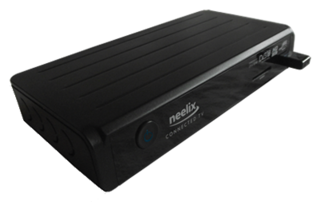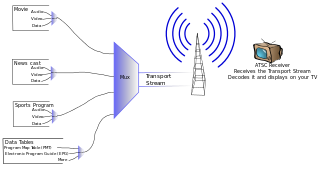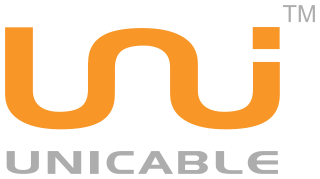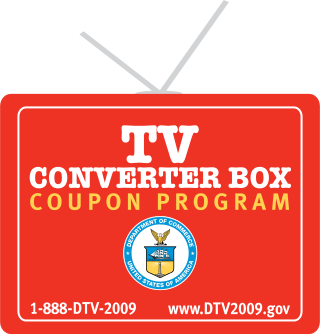
Cable television is a system of delivering television programming to consumers via radio frequency (RF) signals transmitted through coaxial cables, or in more recent systems, light pulses through fibre-optic cables. This contrasts with broadcast television, in which the television signal is transmitted over-the-air by radio waves and received by a television antenna attached to the television; or satellite television, in which the television signal is transmitted over-the-air by radio waves from a communications satellite orbiting the Earth, and received by a satellite dish antenna on the roof. FM radio programming, high-speed Internet, telephone services, and similar non-television services may also be provided through these cables. Analog television was standard in the 20th century, but since the 2000s, cable systems have been upgraded to digital cable operation.

Digital television (DTV) is the transmission of television signals using digital encoding, in contrast to the earlier analog television technology which used analog signals. At the time of its development it was considered an innovative advancement and represented the first significant evolution in television technology since color television in the 1950s. Modern digital television is transmitted in high-definition television (HDTV) with greater resolution than analog TV. It typically uses a widescreen aspect ratio in contrast to the narrower format (4:3) of analog TV. It makes more economical use of scarce radio spectrum space; it can transmit up to seven channels in the same bandwidth as a single analog channel, and provides many new features that analog television cannot. A transition from analog to digital broadcasting began around 2000. Different digital television broadcasting standards have been adopted in different parts of the world; below are the more widely used standards:

A set-top box (STB), also colloquially known as a cable box or receiver and historically television decoder, is an information appliance device that generally contains a TV-tuner input and displays output to a television set and an external source of signal, turning the source signal into content in a form that can then be displayed on the television screen or other display device. They are used in cable television, satellite television, and over-the-air television systems as well as other uses.

An RF modulator is an electronic device used to convert signals from devices such as media players, VCRs and game consoles to a format that can be handled by a device designed to receive a modulated RF input, such as a radio or television receiver. Its input is a baseband signal, which is used to modulate a radio frequency source.

SCART is a French-originated standard and associated 21-pin connector for connecting audio-visual (AV) equipment. The name SCART comes from Syndicat des Constructeurs d'Appareils Radiorécepteurs et Téléviseurs, "Radio and Television Receiver Manufacturers' Association", the French organisation that created the connector in the mid-1970s. The related European standard EN 50049 has then been refined and published in 1978 by CENELEC, calling it péritelevision, but it is commonly called by the abbreviation péritel in French.

The All-Channel Receiver Act of 1962 (ACRA), commonly known as the All-Channels Act, was passed by the United States Congress in 1961, to allow the Federal Communications Commission to require that all television set manufacturers must include UHF tuners, so that new UHF-band TV stations could be received by the public. This was a problem at the time since most affiliated stations of the Big Three television networks were well-established on VHF, while many local-only stations on UHF were struggling for survival.

A tuner is a subsystem that receives radio frequency (RF) transmissions, such as FM broadcasting, and converts the selected carrier frequency and its associated bandwidth into a fixed frequency that is suitable for further processing, usually because a lower frequency is used on the output. Broadcast FM/AM transmissions usually feed this intermediate frequency (IF) directly into a demodulator that converts the radio signal into audio-frequency signals that can be fed into an amplifier to drive a loudspeaker.
A DVD recorder is an optical disc recorder that uses optical disc recording technologies to digitally record analog or digital signals onto blank writable DVD media. Such devices are available as either installable drives for computers or as standalone components for use in television studios or home theater systems.

A composite monitor or composite video monitor is any analog video display that receives input in the form of an analog composite video signal to a defined specification. A composite video signal encodes all information on a single conductor; a composite cable has a single live conductor plus earth. Other equipment with display functionality includes monitors with more advanced interfaces and connectors giving a better picture, including analog VGA, and digital DVI, HDMI, and DisplayPort; and television (TV) receivers which are self-contained, receiving and displaying video RF broadcasts received with an internal tuner. Video monitors are used for displaying computer output, closed-circuit television and other applications requiring a two-dimensional monochrome or colour image.

An ATSCtuner, often called an ATSC receiver or HDTV tuner, is a type of television tuner that allows reception of digital television (DTV) television channels that use ATSC standards, as transmitted by television stations in North America, parts of Central America, and South Korea. Such tuners are usually integrated into a television set, VCR, digital video recorder (DVR), or set-top box which provides audio/video output connectors of various types.

Single-cable distribution is a satellite TV technology that enables the delivery of broadcast programming to multiple users over a single coaxial cable, and eliminates the numerous cables required to support consumer electronics devices such as twin-tuner digital video recorders (DVRs) and high-end receivers.

A digital television adapter (DTA), commonly known as a converter box or decoder box, is a television tuner that receives a digital television (DTV) transmission, and converts the digital signal into an analog signal that can be received and displayed on an analog television set. Some also have an HDMI output since some TVs with HDMI do not have a digital tuner. The input digital signal may be over-the-air terrestrial television signals received by a television antenna, or signals from a digital cable system. It normally does not refer to satellite TV, which has always required a set-top box either to operate the big satellite dish, or to be the integrated receiver/decoder (IRD) in the case of direct-broadcast satellites (DBS).

A coupon-eligible converter box (CECB) was a digital television adapter that met eligibility specifications for subsidy "coupons" from the United States government. The subsidy program was enacted to provide terrestrial television viewers with an affordable way to continue receiving free digital terrestrial television services after the nation's television service transitioned to digital transmission and analog transmissions ceased. The specification was developed by the National Telecommunications and Information Administration (NTIA), with input from the broadcast and consumer electronics industries as well as public interest groups.

A DTV receiver is a set-top box that permits the reception of digital television. Its components are very similar to a desktop PC. The DTV receiver is a vital link in the chain of television system. The goal of a broadcasting system is to concentrate the hardware requirements at the source to simplify the receivers and makes it as inexpensive as possible.
Digital television in the United States is available via digital terrestrial television (DTT), digital cable, satellite television, and IPTV providers.
CEA-909 is the ANSI standard for 8VSB/ATSC smart antennas. The basic concept is that the smart antenna either physically rotates toward the signal, or is stationary, but has elements pointed in different directions and uses only those elements that maximize the received signal. This is accomplished by feedback from the control device, such as a digital-to-analog converter box, telling the smart antenna when the signal is stronger or weaker.

A cable converter box or television converter box is an electronic tuning device that transposes/converts channels from a cable television service to an analog RF signal on a single channel, usually VHF channel 3 or 4, or to a different output for digital televisions such as HDMI.
The digital transition in the United States was the switchover from analog to exclusively digital broadcasting of terrestrial television programming. According to David Rehr, then president and CEO of the National Association of Broadcasters, this transition represented "the most significant advancement of television technology since color TV was introduced." For full-power TV stations, the transition went into effect on June 12, 2009, with stations ending regular programming on their analog signals no later than 11:59 p.m. local time that day.
The Community Broadcasters Association (CBA) was a trade organization representing low-power broadcasting interests, including LPTV and Class A television stations, in the United States of America. It ceased operations in 2009.
In broadcasting, a transposer or translator is a device in or beyond the service area of a radio or television station transmitter that rebroadcasts signals to receivers which can’t properly receive the signals of the transmitter because of a physical obstruction. A translator receives the signals of the transmitter and rebroadcasts the signals to the area of poor reception. Sometimes the translator is also called a relay transmitter, rebroadcast transmitter or transposer. Since translators are used to cover a small shadowed area, their output powers are usually lower than that of the radio or television station transmitters feeding them.













